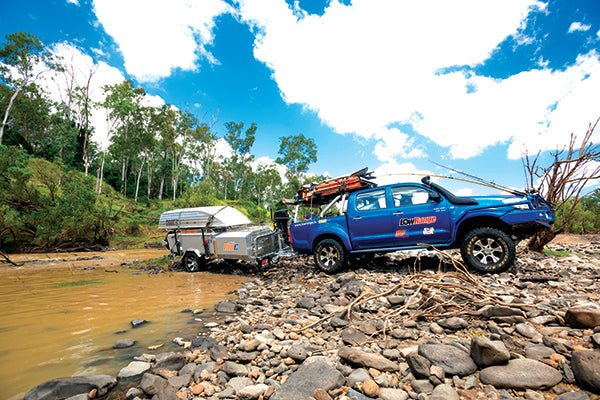
Touring with your boat… the right way
|
|
Time to read 3 min
|
|
Time to read 3 min
One of the best things to add to your travelling rig is some form of boat, but it’s amazing how many people tell you they did exactly that, and got it wrong. Usually, it’s because the boat and motor severely cramped their rig somehow. You see plenty of small boat motors mounted on A-frames and in the backs of utes but, without some planning, they can be pretty awkward.
Mind you, if you love your fishing and you’re heading north, a boat’s almost mandatory. I’ve got mates who won’t leave home without one!
If your rig has been engineered to take it, then fine, chances are it’ll work and work well. My biggest fear, though, is the people who figure that as long as they can fit the boat and motor somewhere, they can cart it anywhere! Hmmm...
Think of it like this. A 10hp boat motor weighs in around 40kg on average. That’s about the same as a spare tyre with a steel rim, so if you’ve got a spare wheel carrier not being used for a spare wheel, bingo. Unfortunately, that prompts the question ‘where’s your spares?’
Yes, that was plural. If you’re heading offroad, or even reasonably remote, there’s nothing like the security of a couple of spares. And don’t go without packing a decent tyre plugging kit, too. What’s decent? Anything from a good 4WD shop should work and, yes, they cost more than the cheapies. But it’s cheap insurance when you’re on the side of the road.
One of the most popular places for a boat motor is the A-frame. That’s fine, but factor in the location and weight and you have a severe ball loading issue, unless you’ve engineered things accordingly. I saw a chap on the Gibb River Road once with a 15hp motor on special brackets he’d welded to the front of his ‘offroad’ van, which had been ‘balanced’ ball weight-wise by adding a big trunk on the rear bar of the trailer to hold all the camping ancillaries.
The boat was on a rack on top of his dual cab, but that wasn’t the problem – a bent trailer axle was. I’m pretty sure what had happened in that case was the constant hammering at each end of the van chassis had created forces that had to go somewhere. The bent axle was possibly a whole lot better than a cracked chassis but, either way, the further you move weight from the centre of a trailer, the more chance you have of disaster.
Talking disaster, on my last trip I ran into a lady driving slowly home towing a big tandem van behind a 200 Series LandCruiser. She was fuelling up in Rockhampton and, noting the dust and mud on the rig, we started chatting. There was an empty motor bracket on the A-frame and the roof rack of the wagon had an empty roller cradle, too.
Her husband had jiggled the boat off easily with her help and then pulled his back lifting the motor on to the transom of the tinny. As it happened on slippery mud on the edge of the creek, he’d been lucky to be able to crawl out without drowning. Fortunately, they had a satellite phone and had managed to get him out quickly. Too quickly to recover the boat or motor, but fellow campers had promised to help.
So, the best boat racks on camper trailers feature hinged frames that swing from points equidistant from the axle and are mounted directly on the body of the trailer itself. These will last, with luck, and don’t take too much effort to load. If the motor is similarly disposed – or perhaps it’s the mighty 2hp model, you’re supposed to be relaxing anyway – then the job’s done easy. But there’s always someone who can prove you wrong...
Let’s hope it’s not someone from the Department of Transport, especially if you’re putting that boat on the roof. In fairness, I’ve never seen it yet but that worries me because I figure there’s always going to be a first time and probably, knowing our uniformed brethren’s management structure, when it does happen, it’ll be a blitz.
The thing is that every vehicle’s roof has a rating determined by the manufacturer. That’s usually somewhere between 50 and 100kg – the Pajero’s is 60kg, for example – and with a tinny weighing maybe 80kg you can see how easy it can be to exceed the legal limit. And it’s not always a ‘legal’ thing – add plenty of corrugations and a tight corner and it’s easy to rock the boat, so to speak!
My choice for roof racks is always the aluminium ones. They save a heap of weight and, if well engineered, can be just as strong. One of the best ones available in recent years is the FrontRunner system from Africa. You get a lightweight, flat and very stable platform that’s super secure – one can only presume Africa’s tracks are as bad as ours.
Surprisingly, they offer an excellent canoe or kayak carrying system for their racks, too. Why surprised? Well, I’m not too sure I’d like to go canoeing with the rhinos. Our crocs are scary enough.
Righto, when it comes to carting some form of boat, don’t be put off! Just get it right before you leave home. It’s amazing how much of this wonderful country can be opened right up with a boat.